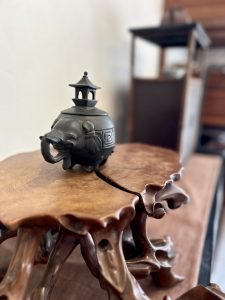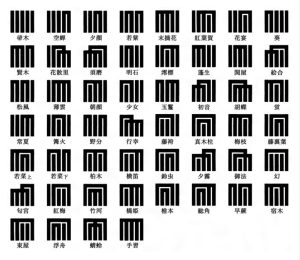梅雨の時期、香りでリフレッシュするのはいかがでしょう(愛知県名古屋市千種区姫池通 骨董買取 古美術風光舎)
2024.06.29
皆さまこんにちは。スタッフHでございます。
梅雨の晴れ間、皆様いかがお過ごしでしょうか。
湿気のせいか室内の空気がよどんでいる気がします。先日より香木について綴っているせいか家で眠っていた線香やアロマグッズなどを引っ張り出して使っております。気分がすっきりする気がいたします。

古の日本人も香りにはとても敏感だったようで、室町時代の終わりごろに生まれた「香道」は「茶道」「華道」と同様に日本の「三道」として今日まで継承されています。
香道には様々な流派が存在しますが、室町時代から続く武家の流派とも呼ばれ、道具も簡素なものが多い「志野流」と和歌などの華やかな公家の文化を背景とし、お道具も煌びやかな「御家流」が二大流派として認識されているようです。
香木の一片を燃やさずに温めて香りを立て、その微妙な香りを聞きとる「聞香」が基本です。「聞香」で複数の香木の香りを聞き分けることが、香りを当てる遊びのような形となり、香りで文学や季節を楽しむ「組香(くみこう)」と呼ばれる遊戯に発展しました。
組香を深く楽しむために様々な作法や決まり事が生まれ、源氏香、花月香、古今香、七夕香、月雨香など季節などの風情を取り込んだ様々な種類の競技が考え出されました。
例えば源氏香では5種類の香木を用意し、それぞれ5包つずの香包に包んで25の包を用意します。その中から無作為に5包を選び香炉で焚いていきます。
香炉を参加者全員に順番に回し種類の香りを聞きます。紙に5本の縦線を書き、5種類のうち同じ香りだと思った香りは横線で結びます。出来上がる図柄は52通りとなり(数学の「くみあわせ」を思い出す方もいるのではないしょうか)52通りそれぞれに源氏物語の章の名前が当てはめられています。この図柄は着物の柄にも使われているようです。

源氏香フリー素材より
この図をみると当てるのはかなり難しそうですが、正解することよりも香に敬意を払いながら、香を味わうことに集中することが大切だと言われています。機会があればぜひ挑戦し、足利義政が体系化した「六国五味」をぜひ体験してみたいものです。
香を焚く作法は流派によって違いがあるようですが、基本的には香元(こうもと)が7種類の火道具である火筋 (こじ)、灰押 (はいおさえ・はいおし)、羽箒 (はぼうき)、銀葉挟 (ぎんようばさみ)、香筋 (きょうじ)、香匙 (こうさじ)、鶯 (うぐいす)を使い聞香炉の灰を整え、その上に銀葉と呼ばれる雲母版を置き、さらに一片の香木を載せます。
正客から順番に香炉が回され、香炉を左手で水平に持ち右手で覆って3回ほど香りを聞き分け次の人へ回します。
静けさのなかで粛々と進んでいく席の空気は、座禅の瞑想の場にも近いものがあるような気がします。
香道の道具も流派によって違いがあるようですが、主なものとして香りを焚くために必要な道具をいれるお盆である「乱箱(みだればこ)」、香りを聞く「聞香炉」、組香で使う香木を包む「香包」、炭団の上にのせ、その上に香木をのせる「銀葉」、銀葉をのせるための台「銀用盤」、銀葉を入れるための箱「銀用箱」などがあります。
蒔絵が施された華やかなものもあるようですので、ぜひ探してみてください。
それでは、また次の機会に。
Hello everyone. This is Staff H.
How are you all doing during the rainy season?
I feel that the air in my room is stale due to the humidity. I have been writing about fragrant woods since the other day, so I pulled out some incense sticks and aroma goods that were sleeping at home and have been using them. I feel refreshed.
The ancient Japanese were also very sensitive to fragrance, and “Kodo,” or the way of incense, which was born around the end of the Muromachi period (1336-1573), has been handed down to this day as one of the “Three Ways” of Japan, along with “Chado” (tea ceremony) and “Kado” (flower arrangement).
There are various schools of Kodo, but the two major schools are the Shino school, which has been practiced by samurai families since the Muromachi period (1333-1573) and has simple tools, and the Oke school, which is based on the gorgeous culture of the court nobles, including waka poems, and has glittering tools.
The basic method is to warm a piece of fragrant wood without burning it to create an aroma, and listen to the subtle fragrance. The process of distinguishing the fragrance of multiple fragrant woods by listening to them became a form of guessing the fragrance, and developed into a game called kumiko, in which literature and seasons are enjoyed through fragrance.
In order to deeply enjoy Kumiko, various manners and rules were developed, and various types of competitions were devised to incorporate seasonal and other aspects, such as Genjiko, Kagetsukiko, Kokin Koko, Tanabatako, and Tsukuyu Koko.
For example, in Genji-ko, five kinds of fragrant woods are prepared, and each of them is wrapped in five incense wrappers, making a total of 25 wrappers. Five of these are randomly selected and burned in an incense burner.
The incense burner is passed around to each participant in turn, and the participants are asked to listen to the different fragrances. Five vertical lines are drawn on a piece of paper, and the five scents that are thought to be the same are connected by a horizontal line. The resulting pattern consists of 52 different patterns, each named after a chapter in the Tale of Genji (some of you may remember the mathematical game “Kumiawase”). This design is also used in kimono patterns.
It is said that it is more important to concentrate on tasting the incense while paying respect to it, rather than trying to guess the correct answer. If you have a chance, I would like you to try it and experience the “Six Provinces and Five Flavors” systematized by Ashikaga Yoshimasa.
Although the manner of burning incense seems to differ from school to school, basically, the kogen (master) uses seven types of fire tools: koji, haioshi, haibouki, ginyoubasami, kyoji, kousaji, and uguisu (bush warbler) to prepare the ashes for the furnace, On top of the ash, a mica plate called a ginga (silver leaf) is placed, and then a piece of fragrant wood is placed on top.
The incense burner is passed from one guest to the next, who holds it horizontally with his left hand and covers it with his right hand, listening to the fragrance three times before passing it on to the next person.
The atmosphere in the quiet and solemn sitting room is similar to that of Zen meditation.
The tools used in kodo also vary from school to school, but the main ones include a “midarebako,” which is a tray to hold the tools necessary for burning incense, an “kobo,” which is used to listen to the fragrance, an “kobo” to wrap the fragrant wood used in kumiko, a “ginba,” which is placed on top of the charcoal burner and on which the fragrant wood is placed, a “ginyoban,” or stand for placing the ginba, and a “ginyo-dan,” or box for holding the ginyobas. A “Ginyo-bako” (box for silver leaves), a stand for placing silver leaves, and a box for holding silver leaves.
Some of them are decorated with maki-e (gold or silver lacquer), so please look for them.
See you next time.
*******************
ご実家の整理やお片付けなどをされている方のご相談などが多くございます。
お片付けなどくれぐれもご無理のないようになさってくださいませ。
風光舎では古美術品や骨董品の他にも絵画や宝石、趣味のお品など様々なジャンルのものを買受しております。
お片付けをされていて、こういうものでもいいのかしらと迷われているものでも、どうぞお気軽にご相談下さいませ。
また風光舎は、出張買取も強化しております。ご近所はもちろん、愛知県内、岐阜県、三重県その他の県へも出張いたします。
まずは、お電話お待ちしております。
愛知県名古屋市千種区姫池通
骨董 買取【古美術 風光舎 名古屋店】
TEL052(734)8444
10:00-18:00 OPEN

